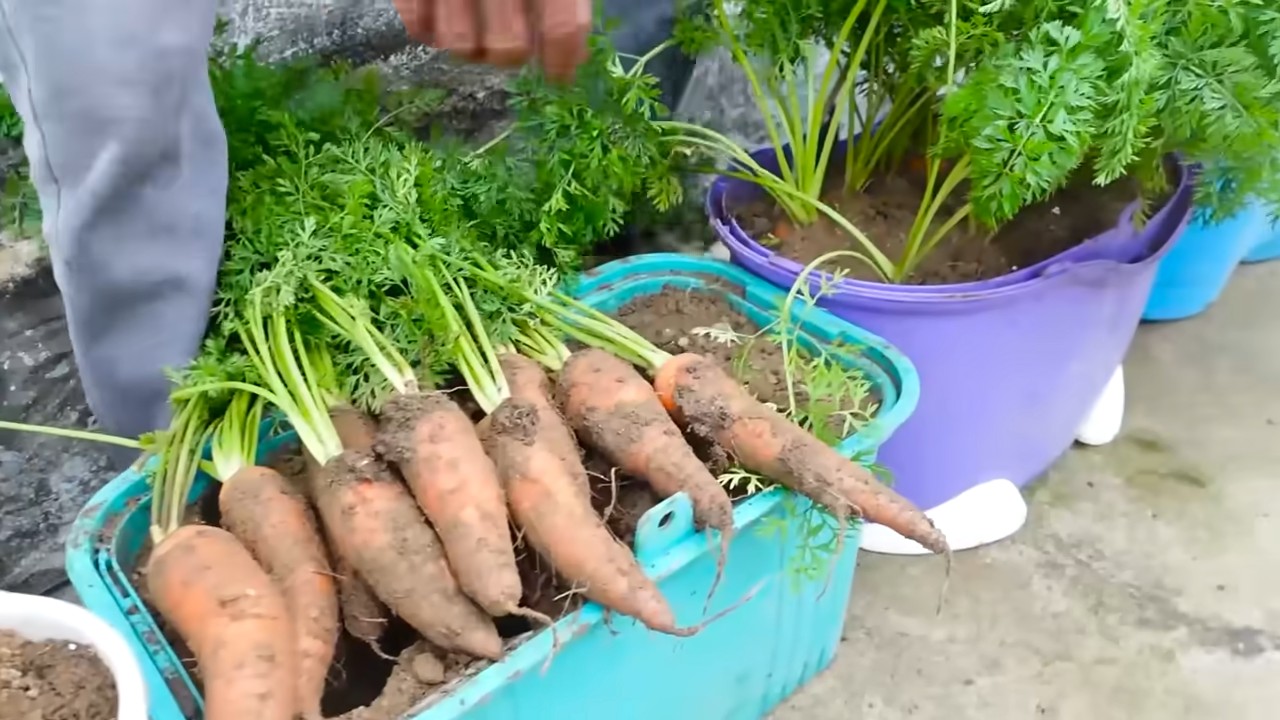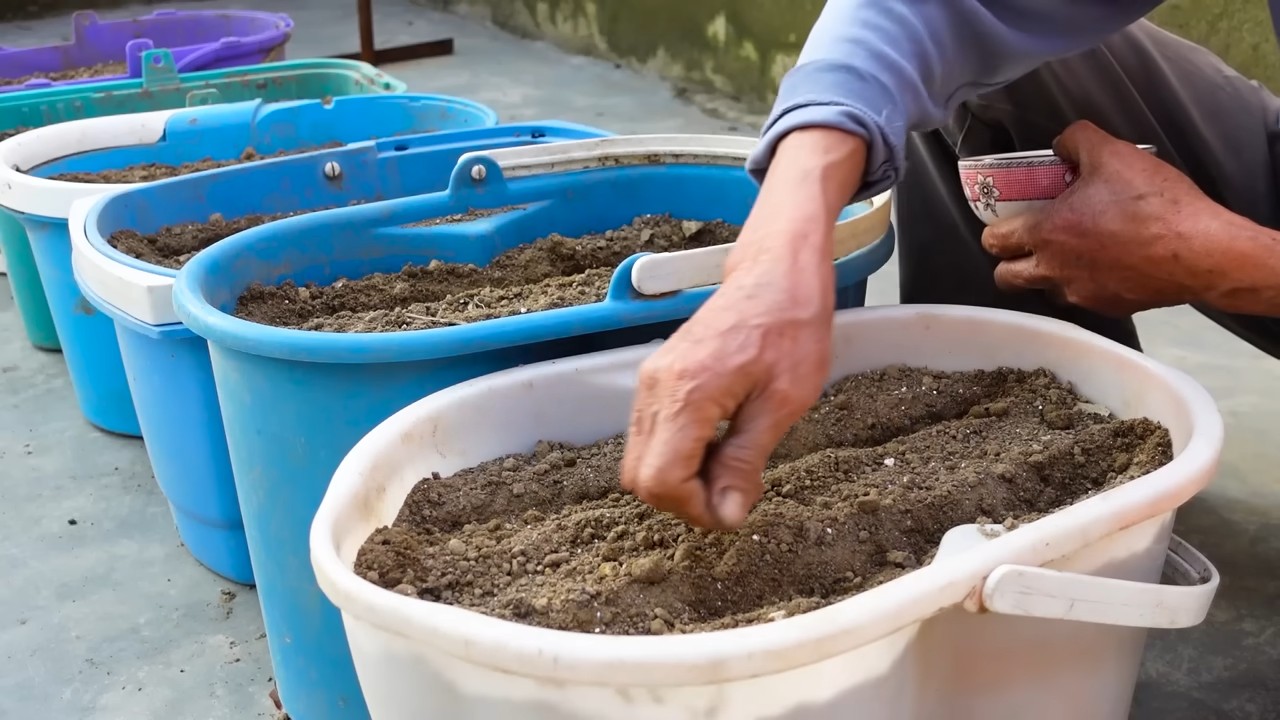Grow Carrots at Home? Absolutely! Imagine plucking vibrant, sweet carrots straight from your backyard, bursting with flavor and freshness you just can’t find in the grocery store. Forget those bland, pre-packaged carrots – we’re talking about homegrown goodness! This isn’t just about gardening; it’s about connecting with nature, enjoying the fruits (or rather, vegetables!) of your labor, and knowing exactly where your food comes from.
Carrots have a rich history, dating back thousands of years. Originally cultivated for their aromatic leaves and seeds, the vibrant orange root we know and love today is a relatively modern development. Over centuries, selective breeding transformed the carrot into the sweet, crunchy treat we enjoy in salads, soups, and as a healthy snack.
But why should you bother learning how to grow carrots at home? Well, for starters, homegrown carrots taste infinitely better! Plus, you can choose from a wider variety of colors and shapes than you’ll ever find in a supermarket. More importantly, growing your own food is incredibly rewarding and empowering. In a world where we’re increasingly disconnected from our food sources, nurturing a small garden can be a powerful way to reconnect with nature and take control of what you eat. This DIY guide will provide you with simple, effective tricks and hacks to ensure a bountiful carrot harvest, even if you’re a complete beginner. Let’s get digging!

Growing Carrots at Home: A Beginner’s Guide
Hey there, fellow gardening enthusiasts! Ever dreamt of pulling a vibrant, crunchy carrot straight from your own backyard? Well, dream no more! Growing carrots at home is surprisingly easy and incredibly rewarding. I’m going to walk you through everything you need to know, from choosing the right variety to harvesting your delicious bounty. Let’s get our hands dirty!
Choosing the Right Carrot Variety
Before we even think about planting, we need to pick the perfect carrot variety for our garden. Carrots come in all shapes and sizes, and some are better suited for certain climates and soil types than others.
* Consider your soil: If you have heavy, clay-rich soil, opt for shorter, rounder varieties like ‘Parisian’ or ‘Thumbelina’. These are less likely to get stunted or misshapen. For looser, sandier soil, you can go for longer varieties like ‘Nantes’ or ‘Imperator’.
* Think about your climate: Shorter, faster-maturing varieties like ‘Little Finger’ are great for areas with shorter growing seasons. If you have a longer growing season, you can experiment with longer, slower-maturing varieties.
* Personal preference: Do you prefer sweet, tender carrots or something with a bit more bite? ‘Nantes’ carrots are known for their sweetness, while ‘Imperator’ carrots are often used for juicing.
I personally love ‘Nantes’ carrots because they’re so sweet and tender, but I also grow ‘Rainbow’ carrots for a bit of fun and variety!
Preparing Your Carrot Bed
Carrots need loose, well-drained soil to thrive. This is probably the most crucial step, so don’t skip it! Rocky or compacted soil will result in forked, stunted, and generally unhappy carrots.
* Choose a sunny spot: Carrots need at least 6 hours of sunlight per day.
* Clear the area: Remove any rocks, weeds, or debris from the planting area.
* Loosen the soil: This is where the elbow grease comes in! Use a garden fork or tiller to loosen the soil to a depth of at least 12 inches. The deeper, the better!
* Amend the soil: Add plenty of compost or well-rotted manure to improve drainage and fertility. Carrots are heavy feeders, so they’ll appreciate the extra nutrients. Avoid adding fresh manure, as it can cause forking.
* Create raised beds (optional): If you have heavy clay soil, consider creating raised beds to improve drainage.
I usually spend a good hour or two just preparing my carrot bed. It’s worth the effort, trust me!
Planting Your Carrot Seeds
Now for the fun part! Planting carrot seeds can be a bit tricky because they’re so tiny, but with a little patience, you’ll get the hang of it.
1. Create shallow furrows: Use your finger or a garden tool to create shallow furrows about 1/4 to 1/2 inch deep and 1-2 inches apart.
2. Sow the seeds: Sprinkle the carrot seeds evenly along the furrows. Don’t sow them too thickly, or you’ll have to thin them later. I like to mix the seeds with sand to make them easier to handle.
3. Cover the seeds: Gently cover the seeds with a thin layer of soil.
4. Water gently: Use a watering can with a gentle rose to water the soil. Be careful not to wash away the seeds.
5. Keep the soil moist: Carrot seeds need consistent moisture to germinate, so keep the soil moist but not soggy. I often cover the bed with burlap or a piece of cardboard to help retain moisture until the seedlings emerge.
6. Be patient: Carrot seeds can take anywhere from 7 to 21 days to germinate, depending on the temperature and soil conditions.
I always feel a little thrill of excitement when I see those first tiny carrot seedlings emerge!
Thinning Your Carrot Seedlings
Thinning is essential for giving your carrots enough space to grow. If you don’t thin them, they’ll compete for resources and you’ll end up with a bunch of skinny, stunted carrots.
1. Wait until the seedlings are about 2 inches tall: This is usually a few weeks after germination.
2. Thin to 1-2 inches apart: Gently pull out the weaker seedlings, leaving the strongest ones to grow.
3. Water after thinning: This will help settle the soil around the remaining seedlings.
I know it can be hard to pull out those tiny seedlings, but it’s for the best! You can even eat the thinnings – they have a mild carrot flavor.
Caring for Your Carrots
Once your carrots are established, they’re relatively low-maintenance. However, there are a few things you can do to help them thrive.
* Water regularly: Carrots need consistent moisture, especially during dry spells. Water deeply and regularly, aiming for about 1 inch of water per week.
* Weed regularly: Weeds can compete with carrots for resources, so keep your carrot bed weed-free.
* Mulch: Apply a layer of mulch around your carrots to help retain moisture, suppress weeds, and regulate soil temperature. Straw, hay, or wood chips are all good options.
* Fertilize (optional): If your soil is poor, you can fertilize your carrots with a balanced fertilizer. Follow the instructions on the fertilizer package. I prefer to use organic fertilizers like compost tea or fish emulsion.
* Protect from pests: Carrot rust flies and carrot weevils can be a problem in some areas. Cover your carrots with row covers to protect them from these pests.
I always enjoy spending a few minutes each day checking on my carrots and making sure they’re happy and healthy.
Harvesting Your Carrots
The moment we’ve all been waiting for! Harvesting your carrots is the most rewarding part of the process.
1. Check the maturity date: The seed packet will tell you how long it takes for your carrots to mature. This is just an estimate, though, so it’s important to check the size of the carrots as well.
2. Check the size: Gently brush away the soil around the top of the carrots to see how big they are. You can harvest them when they’re the size you want.
3. Loosen the soil: Use a garden fork or trowel to loosen the soil around the carrots. This will make them easier to pull out.
4. Pull the carrots: Grasp the carrot tops firmly and gently pull them straight up. If the carrots are stubborn, wiggle them back and forth a little to loosen them.
5. Wash and enjoy: Wash the carrots thoroughly and enjoy them fresh from the garden!
I love the feeling of pulling a perfectly formed carrot out of the ground. It’s like a little treasure!
Troubleshooting Common Carrot Problems
Even with the best care, you might encounter some problems when growing carrots. Here are a few common issues and how to deal with them:
* Forked carrots: This is usually caused by rocky or compacted soil. Make sure to prepare your soil thoroughly before planting.
* Stunted carrots: This can be caused by poor soil, lack of water, or overcrowding. Make sure to amend your soil with compost, water regularly, and thin your seedlings properly.
* Carrot rust flies: These pests lay their eggs near the base of the carrots, and the larvae burrow into the roots. Cover your carrots with row covers to prevent them from laying eggs.
* Cracked carrots: This is usually caused by inconsistent watering. Water regularly and deeply, especially during dry spells.
Don’t be discouraged if you encounter problems. Gardening is all about learning and experimenting!
Storing Your Carrots
If you have a bumper crop of carrots, you’ll want to know how to store them properly.
* Remove the tops: Cut off the carrot tops, leaving about 1/2 inch of stem. This will prevent the carrots from drying out.
* Wash the carrots: Wash the carrots thoroughly and let them dry completely.
* Store in a cool, dark place: The ideal storage temperature for carrots is around 32-40°F (0-4°C). You can store them in the refrigerator in a plastic bag or container, or in a root cellar if you have one.
* Store in sand or sawdust: Another option is to store the carrots in a container filled with damp sand or sawdust. This will help keep them moist and prevent them from drying out.
With proper storage, your carrots can last for several months!
Enjoying Your Homegrown Carrots
Now that you’ve grown your own carrots, it’s time to enjoy them! There are so many ways to use them, from eating them raw to roasting them to making carrot cake.
* Raw: Carrots are delicious raw, either

Conclusion
So, there you have it! Growing carrots at home, while it might seem daunting at first, is a surprisingly rewarding and accessible endeavor. We’ve walked you through the key steps, from selecting the right carrot variety to nurturing your seedlings and finally, harvesting those vibrant, homegrown treasures. But why should you bother with all this effort when you can simply buy carrots at the store?
The answer lies in the unparalleled freshness and flavor. Store-bought carrots, while convenient, often lack the intense sweetness and satisfying crunch of those you’ve nurtured yourself. Plus, you have complete control over the growing process, ensuring that your carrots are free from harmful pesticides and herbicides. You know exactly what went into them – sunshine, water, and your own loving care.
Beyond the superior taste and health benefits, growing carrots at home offers a unique connection to nature. There’s something deeply satisfying about watching a tiny seed transform into a vibrant, edible root. It’s a tangible reminder of the power of nature and your own ability to cultivate life. It’s also a fantastic way to get kids involved in gardening and teach them about where their food comes from.
And let’s not forget the sheer variety you can explore! Forget the standard orange carrots you find in the supermarket. With home gardening, you can experiment with purple, yellow, white, and even round carrots. Each variety offers a unique flavor profile and visual appeal, adding a touch of excitement to your meals.
Ready to take your carrot game to the next level? Consider these variations:
* Container Gardening: If you’re short on space, growing carrots in containers is a perfect solution. Choose a deep container (at least 12 inches) and use a well-draining potting mix. Dwarf or shorter carrot varieties are ideal for container gardening.
* Succession Planting: To enjoy a continuous harvest of carrots throughout the growing season, try succession planting. Sow a new batch of seeds every few weeks.
* Companion Planting: Carrots thrive when planted alongside certain companion plants. Onions, garlic, and rosemary are excellent choices, as they help deter pests and improve soil health.
* Hydroponic Carrots: For the adventurous gardener, consider growing carrots hydroponically. This method involves growing plants without soil, using a nutrient-rich water solution.
Growing carrots at home is more than just a gardening project; it’s an investment in your health, your taste buds, and your connection to the natural world. It’s a chance to experience the joy of nurturing life and reaping the rewards of your labor.
So, grab your seeds, prepare your soil, and get ready to embark on a carrot-growing adventure. We’re confident that you’ll be amazed by the results. And most importantly, don’t forget to share your experiences with us! We’d love to hear about your successes, your challenges, and your favorite carrot varieties. Share your photos and tips in the comments below, and let’s create a community of thriving home gardeners. Happy growing!
Frequently Asked Questions (FAQ)
What is the best time of year to plant carrots?
The best time to plant carrots depends on your climate. In general, carrots are a cool-season crop, meaning they thrive in temperatures between 60°F and 70°F (15°C and 21°C). For most regions, this means planting carrots in early spring or late summer/early fall. Spring plantings should occur as soon as the soil can be worked, typically a few weeks before the last expected frost. Fall plantings should be timed so that carrots have enough time to mature before the first hard frost. Check your local gardening calendar for specific planting dates in your area.
How much sunlight do carrots need?
Carrots need at least six hours of sunlight per day to thrive. Choose a planting location that receives full sun for the majority of the day. If you’re growing carrots in containers, you can move them around to ensure they get adequate sunlight. Insufficient sunlight can result in stunted growth and pale, underdeveloped carrots.
What kind of soil is best for growing carrots?
Carrots prefer loose, well-drained soil that is rich in organic matter. Heavy clay soil can hinder root development, resulting in short, stubby carrots. Amend heavy soil with compost, aged manure, or other organic materials to improve drainage and aeration. The ideal soil pH for carrots is between 6.0 and 6.8. Avoid using fresh manure, as it can cause forked roots.
How often should I water my carrots?
Carrots need consistent moisture to grow properly. Water deeply and regularly, especially during dry periods. Aim to keep the soil consistently moist but not waterlogged. Overwatering can lead to root rot, while underwatering can cause carrots to become tough and bitter. A good rule of thumb is to water when the top inch of soil feels dry to the touch. Mulching around your carrot plants can help retain moisture and suppress weeds.
How do I prevent pests from attacking my carrots?
Several pests can attack carrots, including carrot rust flies, aphids, and nematodes. To prevent pest problems, practice good garden hygiene. Remove weeds and debris that can harbor pests. Use row covers to protect your plants from flying insects. Companion planting with onions, garlic, or rosemary can also help deter pests. If you encounter pest problems, consider using organic pest control methods, such as insecticidal soap or neem oil.
Why are my carrots forked or split?
Forked or split carrots are often caused by compacted soil or rocks in the soil. When the carrot root encounters an obstacle, it splits or forks to grow around it. To prevent this, ensure that your soil is loose and well-drained. Remove any rocks or debris from the planting area. Avoid using fresh manure, as it can also contribute to forked roots.
When are carrots ready to harvest?
Carrots are typically ready to harvest 60-80 days after planting, depending on the variety. Check the seed packet for specific maturity dates. You can harvest carrots when they reach the desired size. Gently loosen the soil around the carrots and pull them up by the greens. If the soil is dry, water it thoroughly before harvesting to make it easier to pull the carrots.
Can I grow carrots in containers?
Yes, you can definitely grow carrots in containers! Choose a container that is at least 12 inches deep to accommodate the carrot roots. Use a well-draining potting mix and ensure that the container has drainage holes. Dwarf or shorter carrot varieties are best suited for container gardening. Water regularly and fertilize as needed.
How do I store harvested carrots?
To store harvested carrots, remove the greens and brush off any excess soil. Store the carrots in a cool, dark, and humid place, such as the refrigerator. You can wrap them in a damp paper towel or store them in a plastic bag with a few holes for ventilation. Carrots can typically be stored for several weeks in the refrigerator. You can also freeze carrots for longer storage. Blanch them in boiling water for a few minutes, then cool them in ice water before freezing.
What are some good companion plants for carrots?
Good companion plants for carrots include onions, garlic, rosemary, sage, marigolds, and lettuce. Onions and garlic help deter carrot rust flies, while rosemary and sage repel other pests. Marigolds attract beneficial insects that prey on pests. Lettuce provides shade and helps keep the soil cool. Avoid planting carrots near dill or fennel, as they can attract aphids.





Leave a Comment